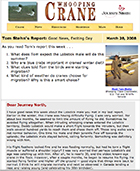Today's Report Includes:
- The Migration : Map, Data and Highlights >>
- Field Reports: Migration in Full Swing! >>
- Journal Question: Why Two Eggs? >>
-
Links: This Week's Crane Resources >>
Here
are #716, 717, 721, 724 and 726 at a migration stopover.
How fast did
they
fly? >>
Photo Anna Fasoli
|
Maps
and Data
|
||
|
Arrival Log >> |
Map Questions >> |
|
| Highlights | ||
|
Western Flock: In Nebraska, Martha Tacha of the USFWS reports, "Migration is in full swing. A total of 24 whooping cranes have been confirmed in Nebraska in the last week! I've received no reports of whooping cranes, confirmed or otherwise, north of central Nebraska." Still on the Texas wintering grounds at Aransas NWR are the remaining members of the 266-bird natural flock — but not for long! Eastern Flock: Nobody's home at the Florida pen! Five of the final six birds of the ultralight-led cohort took off on migration April 1. The sixth, Crane #735, is the first arrival back in Wisconsin, but she flew the route in one day aboard a small private plane. She will be cared for in a pen at Necedah NWR until she can fly again. See the youngsters' migration photos in Sara's report, and find out why everyone celebrates the return of female #309.
|
||
Photo Anna Fasoli, ICF |
||
|
Read
>> |
Read
>> |
|
|
Western Flock Report: For eons the natural flock has shown us that Whooping cranes normally migrate in small groups. This week biologist Tom Stehn discusses the advantages and disadvantages of migrating in small groups — but he also shares how cranes sometimes surprise us! >> Eastern Flock Report: At the new flock's summer home in Wisconsin, cranes are flying in and ICF's Sara Zimorski has exciting news about the latest arrivals. Which Class of 2007 crane-kid came home in an airplane? And which whooper FINALLY migrated back to Wisconsin for the first time since she followed the ultralight planes south in 2003? See why Sara says looking for whooper arrivals is like a treasure hunt! >> |
||
If you think it's tough being the younger sibling, be glad you are not a Whooping Crane chick! In his story about why the Whooping Crane population grows so slowly, Tom Stehn tells why. He also compares this endangered species to the story about the tortoise racing the hare. See why, and then give some thought to the big question Tom asks:
- If only one chick usually survives, why do whooping cranes lay that second egg? Can you think of why a second egg might sometimes be important?
After reading Tom's story, write responses in your Journal. >>
- Explore: Radio Telemetry: Tracking the Cranes >>
- Understand: Crane Population Growth: Why So Slow? >>
- Analyze: The Challenges of Whooping Crane Survival: Learning Lessons from Life Histories >>
- Go Figure: How Fast Did They Fly? >>
- Discover: Whooping Crane Population Totals as of March 31, 2008 >>
- View Video: Dance Like the Cranes! >>
The Next Whooping Crane Migration Update Will Be Posted on April 11, 2008.











